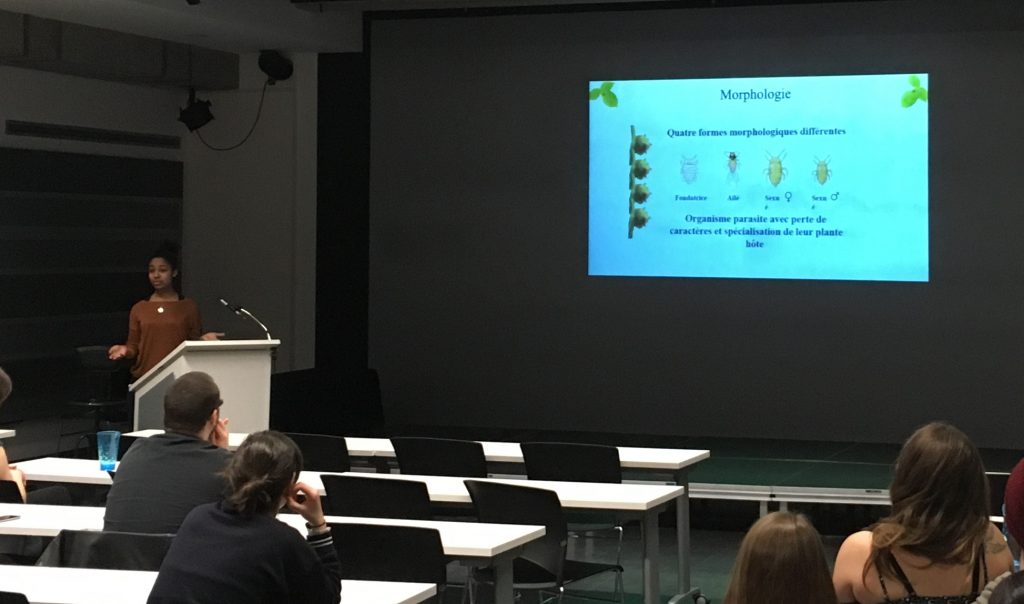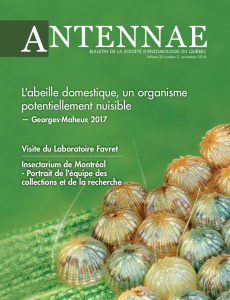• Article: Voegtlin trap
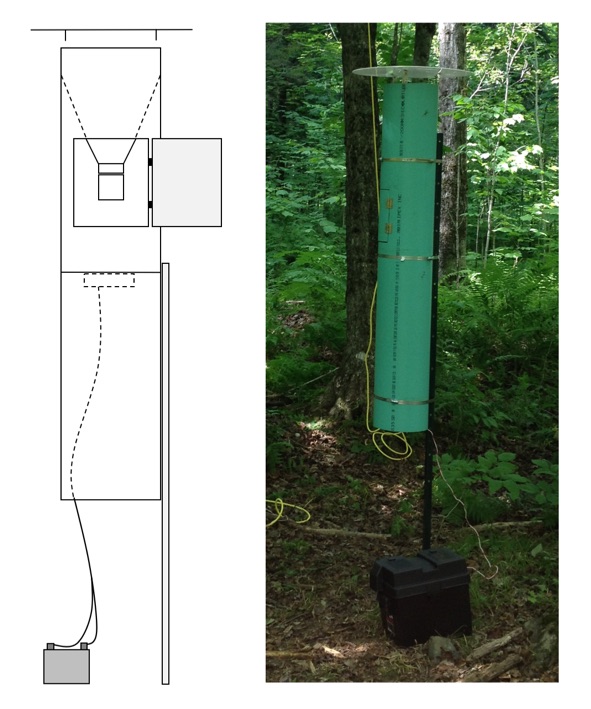
During my M.S. research, my advisor David Voegtlin gave me a set of medium-sized suction traps that he had developed and built for catching aphids. As I sorted hundreds of aphids, I was amazed at the diversity of other insects in the traps and vowed that I would one day take a closer look at it. One of the first things I did when I arrived at the University of Montreal, was to build my own set of “Voegtlin traps” and set them up along a 150 m transect in the forest of the University’s Laurentian Biological Research Laboratory. We sampled several summer weeks, with suction traps and small Malaise traps set up side by side to compare the efficacy of these two trapping methods.
Over the course of several subsequent years, a small army of undergraduate students sorted the insects in a single week’s worth of that material. One of them, Alexis Trépanier, spent two full semesters classifying the Hymenoptera into “Operational Taxonomic Units”, ending up with just shy of 200 OTUs! He, undergraduate Diptera-sorter Titouan Eon-Le Guern, master’s student computer analyst Vincent Lessard, PhD student Thomas Théry and I just published the results of this project in the journal Insect Conservation and Diversity.
Along with describing the Voegtlin suction trap in detail, we found that these traps were excellent at capturing tiny insects, especially small parasitoid wasps known as Microhymenoptera and the very diverse family Phoridae (true flies, Diptera). Not only are these traps great for species discovery generally, but we found that the ensemble of the insects that they caught was different for each trap along the transect, despite the fact that the traps were only 50 m apart. This suggests that there is a fair amount of insect community heterogeneity in the Laurentian forest.
This summer, we’ve placed three pairs of traps in similar habitat replicates. We’re hoping to find out if that community heterogeneity is more or less random throughout the forest, or if it is patchy, based perhaps on the surrounding vegetation. With any luck, there’ll be a follow-up post in a couple years.
• Article: Digitizing the collection
During the past few years, the Ouellet-Robert Entomological Collection personnel have been working towards increasing the use and value of the Collection. Today, entomology researchers especially need electronic data. In a recent publication, we described three computerization initiatives.
First, we examined each drawer of pinned specimens and each vial rack of alcohol-preserved specimens, and we graded the conservation health of these units across eight criteria (for example, the condition of the specimens, or their labels, or their storage containers). With these data, for internal use only, we are better able to target certain parts of the collection with the greatest need.
Secondly, we created a list of the species in the Collection, the number of individuals of each species, and if at least one specimen was had been collected in Quebec or North America. These data, made available on line, are intended for researchers who want to know what material is the Collection so that they can pay us a visit or ask for a loan or more information. We counted 1.5 million specimens, of which a third are pinned, and 20,000 species, of which half are from Quebec.
Finally, we digitized the specimen label data of certain aquatic insect groups, most importantly the dragonflies and damselflies (Odonata) of which we have a lot of material thanks to the effort of our previous curators, Jean-Guy Pilon and Pierre-Paul Harper, but especially Adrien Robert. These data will be useful for, among others, estimating the geographic distribution of Odonata over time and evaluating the effects of environmental change. In fact, we have already added to this dataset by computerizing the specimen label data of other Quebec insect collections: an article describing the combined dataset is in preparation.
The combination of these three new data resources represent but a starting point for a new digital age in the Ouellet-Robert Collection.
• Thomas receives his PhD
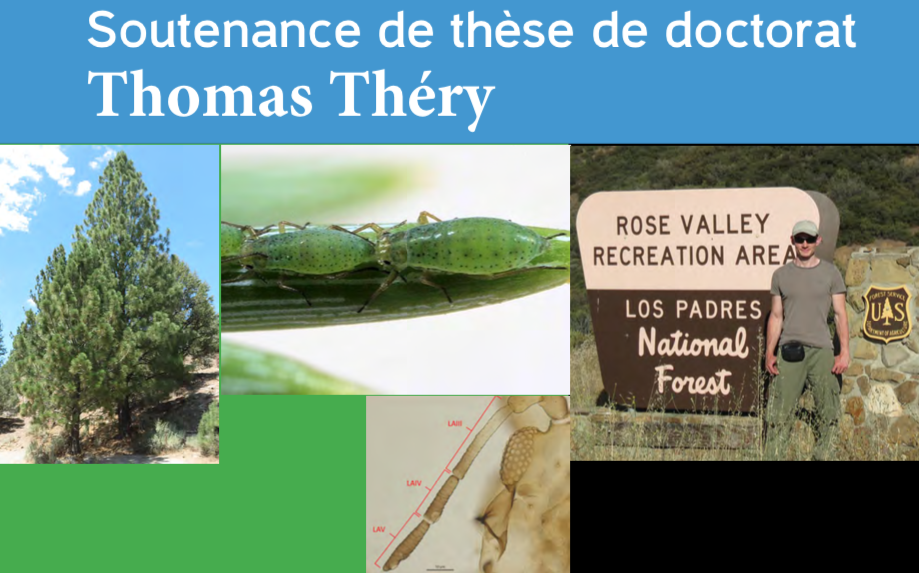
In April 2018, Thomas Théry successfully defended his doctoral dissertation. Almost a year later, his erstwhile advisor publicly celebrates the completion of his first PhD student’s studies. Entitled “Molecular systematics of the genus Essigella (Hemiptera: Sternorrhyncha)“, Thomas’s dissertation presented three published chapters.
Species of the aphid genus Essigella are found natively only in North America, feeding along the lengths of pine needles. The taxonomy of the genus was last treated by John Sorensen in 1994. He used difficult, time-consuming, but effective multi-variate morphometric methods to delineate the species. Thomas sought to corroborate or challenge Sorensen’s taxon concepts using molecular methods. In his first chapter, published in Insect Systematics and Diversity, Thomas used genes from the aphids’ nucleus, mitochondrion, and obligate nutritional symbiont Buchnera aphidicola and several molecular species delimitation methods. It was indeed a relief and a pleasure to find that, by and large, his results corroborated Sorensen’s.
Thomas did find a few additional species, however, and he proceeded to describe and name them formally in his follow-up publication in ZooKeys. Thomas’s species descriptions were innovative in that he used actual genetic nucleotide differences as diagnostic characters for his new species, something rarely done in animal taxonomy and never done before with aphids. Not to court too much controversy, Thomas made certain to include morphological diagnoses as well! The third chapter of Thomas’s dissertation was actually the first one published. We’ve already described that work on the Monterey pine needle aphid colonizing new geographic regions.
Thomas landed a full-time employment at the Insectarium of Montreal, just next door to the Biodiversity Centre, so we are pleased to see him regularly as he comes to work on his beetles at the Ouellet-Robert collection. Yes, that means that despite having worked on aphids for his PhD, we were unsuccessful at taking the histerid out of this coleopterist. We’re proud of you anyway, Dr Théry, congratulations!

Théry T, Kanturski M, Favret C. 2018. Molecular phylogenetic analysis and species delimitation in the pine needle-feeding aphid genus Essigella(Hemiptera, Sternorrhyncha, Aphididae). Insect Systematics and Diversity, 2(4):1;1-15. DOI: 10.1093/isd/ixy006
Théry T, Kanturski M, Favret C. 2018. Molecular data and species diagnosis in Essigella Del Guercio, 1909 (Sternorrhyncha, Aphididae, Lachninae). ZooKeys, 765: 103-122. DOI: 10.3897/zookeys.765.24144
Théry T, Brockerhoff EG, Carnegie AJ, Chen Rui, Elms SR, Hullé M, Glatz R, Ortego J, Qiao Gexia, Turpeau É, Favret C. 2017. EF-1α DNA sequences indicate multiple origins of introduced populations of Essigella californica(Hemiptera, Aphididae). Journal of Economic Entomology, 110(3): 1269-1274. DOI: 10.1093/jee/tox026
• Article: A North American aphid invades new territory
Aphis lugentis is an aphid species relatively common in North America, feeding primarily on Senecio, a genus of the daisy family. This aphid species had recently been found in southern France and in a new publication, we document its presence across the Mediterranean in Tunisia, as well as in South America, namely Argentina, Chile, and Peru. In order to confirm the identity of our samples, we examined them under the microscope and sequenced their barcode gene. Publication of the note in the Proceedings of the Entomological Society of Washington implicated eight co-authors from four countries, including two undergraduate interns in the Favret Lab.
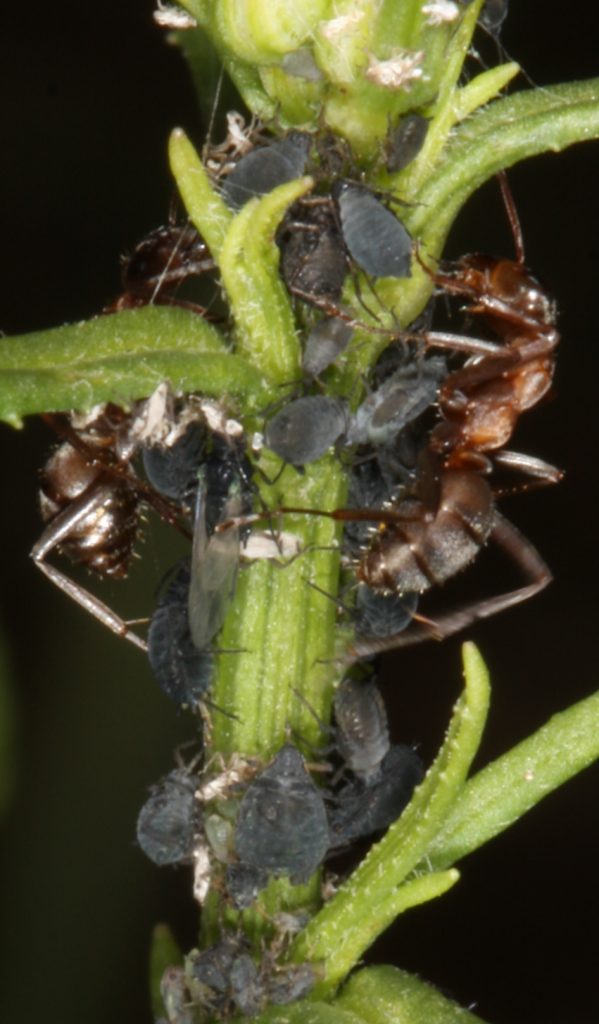
Ortego J, Ayadi M, Ben Halima Kamel M, Juteau V, Marullo-Masson D, Nieto Nafría JM, Bel Khadi MS, Favret C. 2019. The spread of the North American Aphis lugentis Williams (Hemiptera: Aphididae) to Africa and South America. Proceedings of the Entomological Society of Washington, 121(1): 128-134. DOI: 10.4289/0013-8797.121.1.128
• Article: The Cannabis aphid in North America
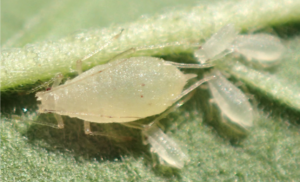
The recreational use of marijuana becomes legal across Canada today. Of course increased cultivation of Cannabis sativa will accelerate research on this species, as was highlighted in the scientific journal Nature. It will also mean the need to protect the crop against insects and other injurious organisms. One such insect is the Cannabis aphid, Phorodon cannabis. This Eurasian species was recently introduced to North America. In a recent publication, my colleagues and I brought attention to the presence of this insect in the United States and Canada, in fields and greenhouses. We also discussed its biology and taxonomy. The aphid has already caused crop damage but its full economic impact remains to be seen.
Cranshaw WS, Halbert SE, Favret C, Britt KE, Miller GL. 2018. Phorodon cannabis Passerini (Hemiptera: Aphididae), a newly recognized pest in North America found on industrial hemp. Insecta Mundi, 662: 1-12. URL: http://journals.fcla.edu/mundi/article/view/107029
• The lab is featured by the SEQ
The members of the lab were featured in the spring (2018) issue of Antennae, the Bulletin of the Quebec Entomology Society. Read it here in French.
• Article: Revision of the mealy plum aphids
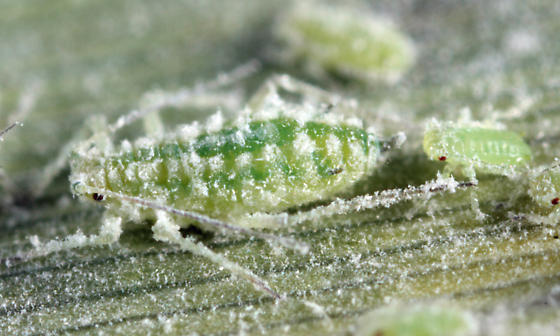
The mealy plum aphid, Hyalopterus pruni, along with two other species of Hyalopterus, are important pests of peaches, apricots, plums, and almonds. Unfortunately, there were 13 separate species names for only three valid species. In order to associate the 13 names with the three species, we published a taxonomic revision of the aphid genus Hyalopterus. The project involved five authors from five different countries, and the results were published at the end of 2017. Establishing the correct names for the three valid species will help researchers on these pest aphids better communicate their work. The paper is available at the Proceedings of the Entomological Society of Washington. Or just drop Colin an e-mail for a personal delivery!
Favret C, Meshram NM, Miller GL, Nieto Nafría JM, Stekolshchikov AV. 2017. The mealy plum aphid and its congeners: A synonymic revision of the Prunus-infesting aphid genus Hyalopterus (Hemiptera: Aphididae). Proceedings of the Entomological Society of Washington, 119(4): 565-574. DOI: 10.4289/0013-8797.119.4.565
• Article: Protecting the name Adelgidae

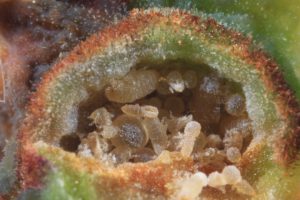
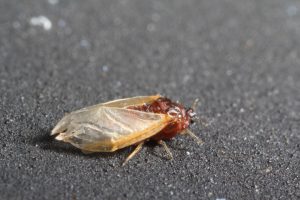
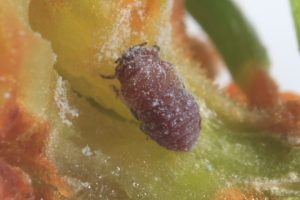
Adelgids are sometime conifer insect pests; of particular note is the hemlock woolly adelgid. A large number of species alternate host, forming galls on a spruce one year and migrating to the bark or needles of another kind of conifer the next (fir, hemlock, larch, pine). While preparing a catalog of adelgid species, I discovered that there are actually three names referring to the same family. According to the rules of the zoological nomenclature, when two scientific names apply to the same animal (synonyms), it is the older that takes precedence. Unfortunately, the other two names, published in 1901 and early 1909, both have priority over Adelgidae, published in late 1909. Because Adelgidae is used much more often than the other names, to protect the stability of the nomenclature and the research on this important insect family, I prepared a petition, submitted to the International Commission of Zoological Nomenclature, to protect the name Adelgidae by suppressing the other two. With the support of many of my fellow aphidologists, I am confident that my request will be granted, but in case it is not, we will have to start using the name Chermaphididae to refer to this family!
Favret C. 2017. Case 3714 – Adelgidae Schouteden, 1909 (Insecta, Hemiptera, Aphidomorpha): proposed conservation by reversal of precedence with Pineini Nüsslin, 1909 and Chermaphidinae Hunter, 1901. Bulletin of Zoological Nomenclature, 74(2): 55-59. DOI: 10.21805/bzn.v74.a019
• Article: Several introductions around the world of a Californian aphid

PhD student Thomas Théry recently published the first chapter of his thesis. Here’s a brief exposé of his work.
Aphids of the genus Essigella live in North America and feed on pine needles. One of these species, Essigella californica, has been introduced in Europe, North Africa, Asia, Oceania and South America. Essigella californica is a species that could cause great damage in pine culture where it has been introduced. Thus research on control methods are undergoing in order to restrain additionnal damage caused by the species. However, it is important to fully grasp the identity of the populations and the biology of the species so that suitable control methods could be brought. This species is morphologically close to many other species of Essigella and no genetic study has confirmed that the introduced populations belonged well to this species. The study of three genes (ATP6, COI, and GND) on twelve introduced populations of Essigella californica has confirmed that these ones belonged to this species. The study of a fourth gene (EF-1α) has revealed that these twelve populations could have been separated into four distinct groups showing that the introduced populations had at least four origins and that the introduction of this species outside North America took place at least four times.
Théry T, Brockerhoff EG, Carnegie AJ, Chen Rui, Elms SR, Hullé M, Glatz R, Ortego J, Qiao Gexia, Turpeau É, Favret C. 2017. EF-1α DNA sequences indicate multiple origins of introduced populations of Essigella californica (Hemiptera, Aphididae). Journal of Economic Entomology, 110(3): 1269-1274. DOI: 10.1093/jee/tox026
• Anaïs wins best presentation at the departmental symposium
Best presentation in ecology and evolution at the 17th annual symposium. Congratulations Anaïs!
